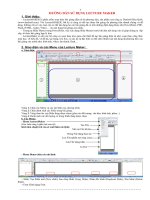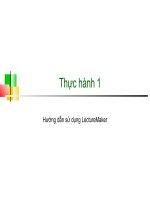cerenkov radiators lecture 7
Bạn đang xem bản rút gọn của tài liệu. Xem và tải ngay bản đầy đủ của tài liệu tại đây (631.38 KB, 14 trang )
18 October, 2001
www.hep.ph.ic.ac.uk/~hallg/
28
Examples of Cerenkov radiators
Radiator n
max
N
0
(cm
-1
)
β = 1
200 <λ< 750nm
He gas 1.000035 0.48° 0.11
Air gas 1.000283 1.36° 0.94
Isobutane gas 1.001270 2.89° 4.3
Aerogel solid 1.025-1.075
12.7-21.5° 81-226
Freon liquid 1.233 35.8° 575
Water liquid 1.33 41.2° 729
Quartz solid 1.46 46.7° 892
BGO solid 2.15 62.3° 1319
18 October, 2001
www.hep.ph.ic.ac.uk/~hallg/
29
Exotics
•Transition radiation
radiation emitted when charged particle crosses dielectric boundary
signals in x-ray region (~ few keV)
very weak radiation - multiple boundaries required to generate measurable signal
but amplitude ~ = 1/(1-
2
)
1/2
particle ID at very high energy
•Bolometers
large fraction of ionisation energy does not appear as electrical signal
in crystals, eg silicon, excites phonons in crystal = heat
quantum of measurement = energy per phonon ~ meV (10
-3
eV!)
potential for very high energy resolution
measure change in T ∆T = E
deposit
/C C = heat capacity of sensor
C ~ mass so need small sensor and low T (near 0K)
nevertheless, some good results ∆E
FWHM
= 17eV at 0.05K for 6keV x-ray
•Superconducting sensors - several types
two metal superconductors separated by thin insulator layer
under bias, QM tunneling of ionised excited states through insulator
~ meV gives potential for high resolution
18 October, 2001
www.hep.ph.ic.ac.uk/~hallg/
30
Application: particle identification
•A common requirement in nuclear and particle physics is to identify which type of
particle is being observed
•stable neutral particles - γ, n
very different types of interaction so easy to distinguish- discuss later
•stable or long-lived charged particles: e
-
, p
+
, π
±
, K
±
, d, He
+
, other ions
typically momentum measurement is made by bending charged particle in B field
Force = qvxB = mv
2
/r => r = qB/p if motion in plane perpendicular to B
direction of bend indicates if charge is + or -
•p and charge are not enough to identify particle, need measurement of m or E
E
2
= m
2
+ p
2
(c = 1 units , m = MeV/c
2
, E = MeV, p = MeV/c)
Two common methods : Time of Flight & Cerenkov
18 October, 2001
www.hep.ph.ic.ac.uk/~hallg/
31
Time of Flight
•Simply measure time taken between two measurement points, separation L
t
1
= L/v
1
t
2
= L/v
2
1/β = E/p ≈ 1+m
2
/2p
2
for p >> m
∆t = t
1
-t
2
= (L/c)(1/β
1
-1/β
2
) ≈ 3.3ns(1/β
1
-1/β
2
) for L = 1m
Since β ~ 1, good measurement accuracy required
∆t = (L/2p
2
c)(m
1
2
-m
2
2
)
m
e
= 0.511 MeV/c
2
m
π
= 140 MeV/c
2
m
K
= 494 MeV/c
2
m
p
= 938 MeV/ c
2
•Requirements
fast scintillator with high photon output
thick scintillator (~few cm) for maximum light signal
fast response photodetector
30
25
20
15
10
5
0
time of flight (ns)
2000150010005000
p (MeV/c)
electron
pi
K
proton
18 October, 2001
www.hep.ph.ic.ac.uk/~hallg/
32
Cerenkov identification
•cosθ = 1/βn so β > 1/n for light emission
•light output N
γ
= N
0
Lsin
2
θ = N
0
L(1-1/β
2
n
2
)
a good figure of merit N
0
≈ 100cm
-1
depends on details of construction and photosensors
for gaseous radiator L > 1m
still expect small Nγ
•threshold counters
binary 0/1 signal
•ring imaging detectors
focussing mirror
cone -> ring
count photons with position sensitive detector
5x10
-3
4
3
2
1
0
sin
2
θ
151050
p (GeV/c)
e
pi
K
p
n = 1.00190 (isobutane gas)
18 October, 2001
www.hep.ph.ic.ac.uk/~hallg/
1
Photodetection
•Many examples of light signals
sensors such as scintillators, Cerenkov radiation,
lasers for telecommunications, cable TV, local or wide area optical network
optoelectronic technology is rapidly growing field with innumerable applications, eg:
optical computing
holographic memories
consumer electronics and data storage (CDs, etc)
•What types of sensor are available for photonic measurements?
•What are the requirements?
•What properties and limitations do they have?
18 October, 2001
www.hep.ph.ic.ac.uk/~hallg/
2
Reminder - Electromagnetic spectrum
• λ = c/ν = hc/E λ [µm] = 1.24/E [eV]
0.2µm = 6eV ultra-violet
0.5µm = 2.4eV visible
1µm = 1.24eV infra-red
10µm = 0.12eV far-IR
•Wide range of photon wavelengths and
energies to be covered!
should not expect a single sensor for
all applications
18 October, 2001
www.hep.ph.ic.ac.uk/~hallg/
3
Photomultiplier
•Most common light sensor - simple structure
electrodes enclosed, in vacuum, in glass envelope
many sizes and shapes
•Photocathode - thin metal coating on inside of entrance window
semi-transparent (& fragile)
photon absorbed and converted to electron, small k.e.
e
-
diffuses to surface and escapes
•Electron capture region
E field shaped to transport e- to first dynode
•Dynodes - electron multiplier chain
e
-
accelerated in E field
strikes dynode and ke. releases more e
-
= amplification
•Anode
after several amplification stages, -> current signal
anode
focussing
electrodes
e
-
e
-
e
-
window
18 October, 2001
www.hep.ph.ic.ac.uk/~hallg/
4
Photomultipliers
18 October, 2001
www.hep.ph.ic.ac.uk/~hallg/
5
Photomultiplier operation
A
C
D
1
D
2
D
3
D
4
D
5
D
D
12
D
13
D
14
-V
R
1
R
2
R
3
R
4
R
5
R
12
R
13
R
14
R
15
R
0
output
•Bias dynodes by applying voltages
typically ~100V stage
G
stage
~ ke of incident electron
•simplest arrangement: resistor potential divider
usually add capacitors in final stages, where current is maximum
can add Zener diodes for stability
•Choice of components
first stage is often largest ∆V for maximum gain
I
chain
>> I
peak signal
18 October, 2001
www.hep.ph.ic.ac.uk/~hallg/
6
Characteristics
•photocathode- determines wavelength sensitivity and quantum efficiency
QE = N
e
/incident photon
3-4 eV alkali metals
1.5-2eV bi-alkali
Signal = G
total
x QE x ε
photon
x ε
electron
ε
photon
= fraction of photons reaching cathode
ε
electron
= electron collection efficiency
•try to match sensitivity to source, eg scintillator spectrum
•very sensitive to magnetic field
electrons are low energy and E field is limited
•stable high voltage required
since gain G
total
~ G
stage
N
~ ∆V
N
~ (V/N)
N
photocathode
type
∆ λ
(nm)
λ
max
(nm)
QE
(%)
name
Ag-O-Cs 300-1100 800 0.4 S1
Bi-Ag-O-Cs 170-700 420 6.8 S10
Cs
3
-Sb-O 160-600 390 19 S11
Na
2
-K-Sb-Cs
160-800 380 22 S20
K
2
-Cs-Sb 170-600 380 27 bialkali
18 October, 2001
www.hep.ph.ic.ac.uk/~hallg/
7
signal in photoelectron equivalents
Sensitivity
•Approximate picture - each stage increases signal by factor δ
stage
Single and multiple electron signals can be distinguished depending on dynode gain
stage gain subject to Poisson statistics (ie. random process)
•if gain is high, first stage dominates
Signal = N
e
δ
1
δ
2
δ
3
δ
4
δ
N
δ
1
= 5
δ
1
= 25
18 October, 2001
www.hep.ph.ic.ac.uk/~hallg/
8
Noise
•Photomultipliers often described as noiseless sensor - but
noise arises from thermionic emission of electrons from cathode and dynodes
dark count rates of ~kHz or more possible - can be minimised in several ways
if signal can be observed in coincidence with another signal
very often possible, eg particle crosses several detectors
cooling tube
minimise dark current
discriminating amplitude of signal -
noise pulses generated after first stage will be smaller amplitude
18 October, 2001
www.hep.ph.ic.ac.uk/~hallg/
9
Channel plate
•Hollow tube of high resistivity glass coated internally with secondary electron emitter
apply potential difference along tube -> multiplication
pack series of tubes as bundle ~ few cm
2
•Intrinsically spatially sensitive
to avoid too many channels read out with resistive anodes, strips or CCD
•Use "chevron" arrangement to avoid positive ion feedback
could damage tube
•Applications
image intensifier - very compact low light detection
spatial imaging - β isotopes
fast timing - transit time short, and dispersion smaller
photocathode
anode









